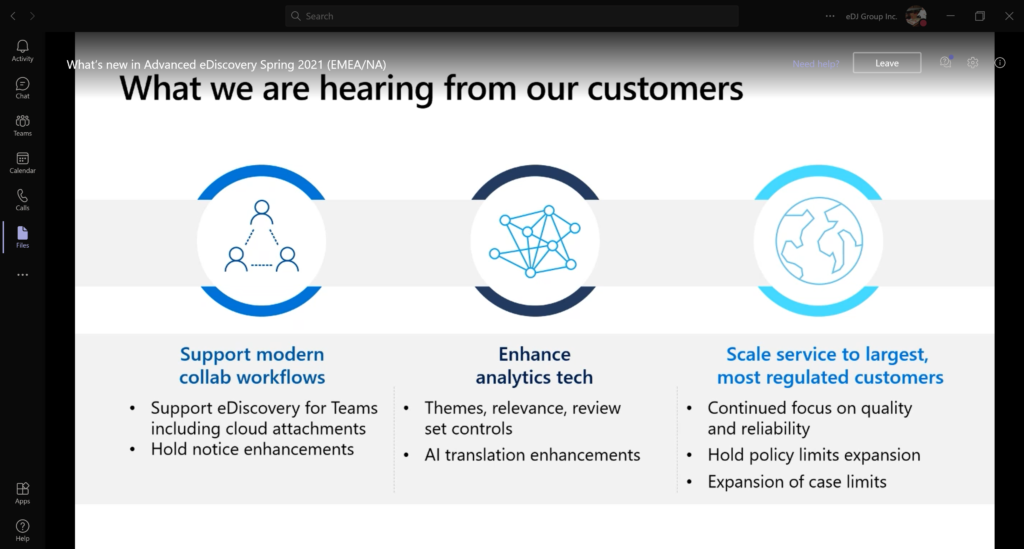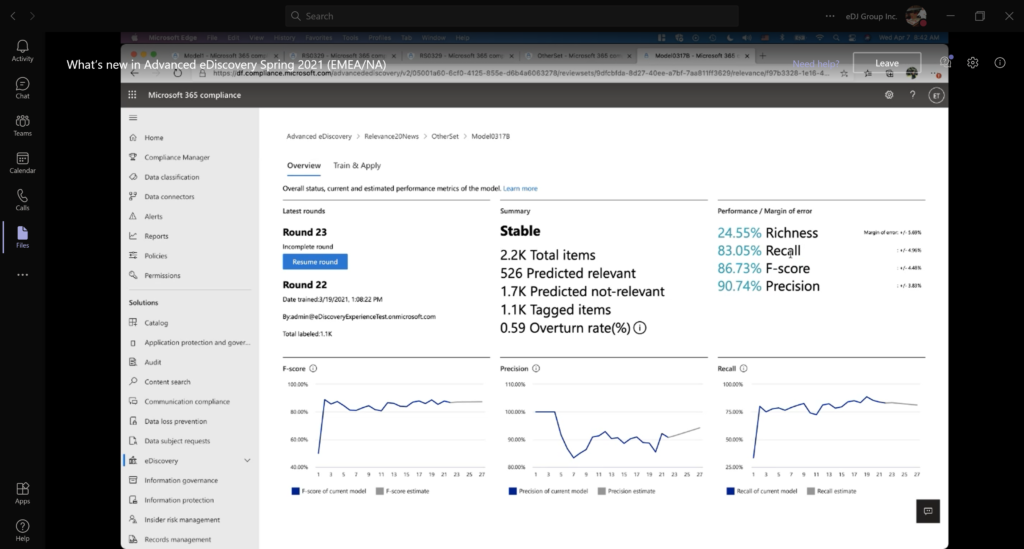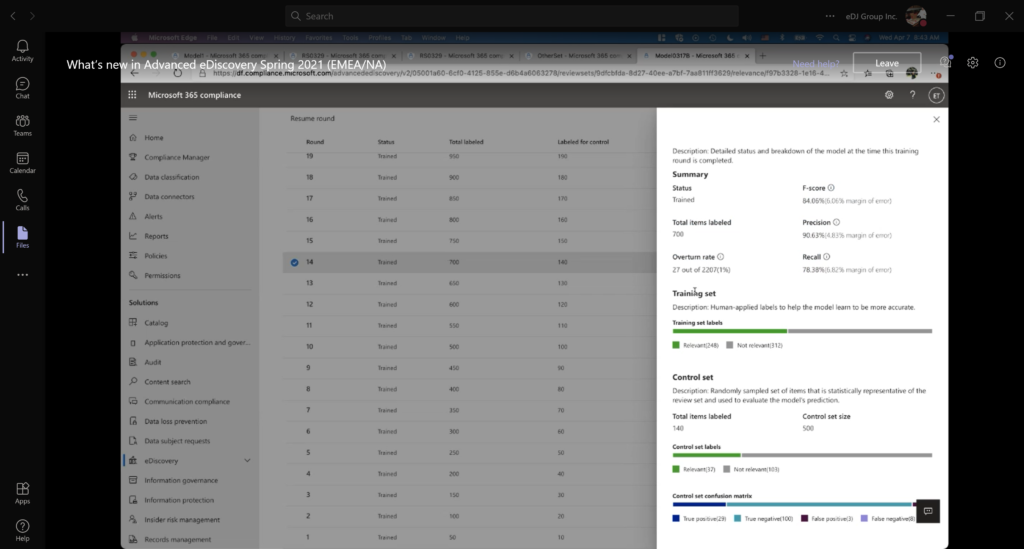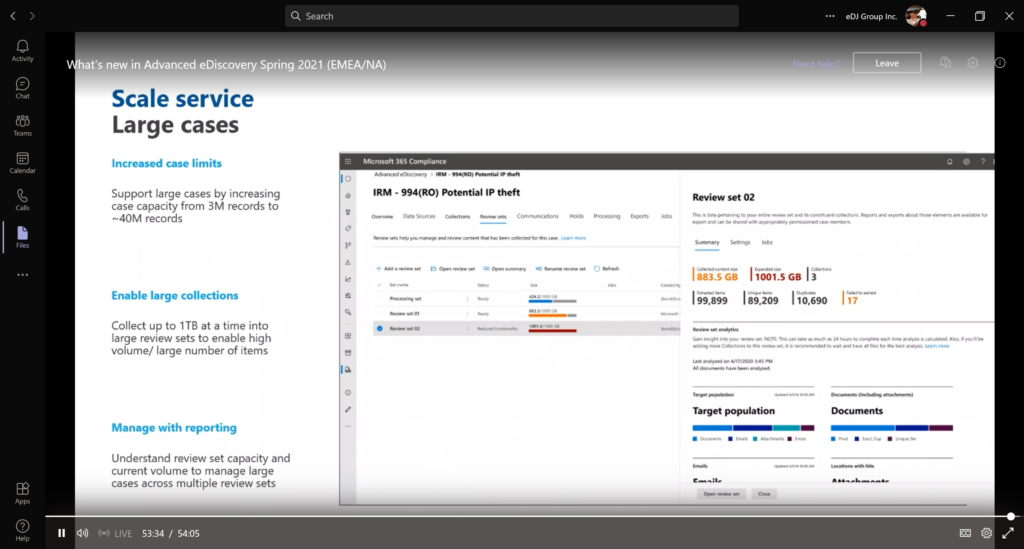Microsoft’s Information & Protection teams are rolling out Advanced eDiscovery(AED) updates at a remarkable rate. The product team’s April 7th webinar and presentation deck has not yet been published, but I wanted to share some perspectives on how these updates may impact AED users. The pandemic has driven E5 license upgrades and features to support remote employees, which makes AED usage more practical for many corporate legal departments. The product team is working hard to meet these customer demands for better performance and scale. They are reporting cull rates of 80-90% from early adopters with mature workflows. That number feels right for corporations who are focused on selective collections/searches vs. raw custodial collections.

The big news is a completely new architecture for AED predictive coding. The GUI has been completely reworked and converted to what I would describe as a Continuous Active Learning (CAL) workflow with training sets as low as 50 docs/round. The training models are still binary (i.e. single topic relevance per model), but reviewers are being fed prioritized documents instead of random sets. Per they roadmap description, this may reduce the training volume by 90% to start seeing output from the model. I like the new PC dashboard and the dynamic status display shown below. This feels like the first major PC workflow update since Equivio was integrated into M365 Compliance Center.


Some relief is coming for AED users who have hit volume limits in collections and review sets. Overall matter limits are expanding from 3M records to ~40M. I am seeing client executive collections regularly exceed 1-2M email, so AED review sets still require selective collections for many cases. Review sets are being expanded to from 100GB to 300GB immediately with a long term goal of 1 TB collections. They are adding capacity reporting to the Review Set dashboard so that users can better manage these limits.

With the explosion of Teams usage during the pandemic has been accompanied by major discovery headaches. I have gotten more inquiries about how to manage Teams content recently than any other data source. AED now supports enhanced collection and review of Teams content through merged chat transcripts and linking of content from OneDrive and SharePoint (where Teams stores ESI). AED users have the option to collect Teams chats as a merged transcript or as individual items to import into their own review platform. This is a step in the right direction and addresses some of the Teams discovery landmines I highlighted last year.

Last month I covered the conversion of AED ‘Searches’ to ‘Collections’. An important clarification from the spring webinar is that the AED deep indexing of search hits does not happen until those items are added to a review set. Previously, deep indexing occurred further upstream, enabling users to understand potential exceptions before building their rather limited volume review sets. There is a reasonable argument that you cannot perform a ‘complete’ keyword search of your target data without first adding it to a review set. My general solution is to perform a baseline analysis of the custodial unindexed content so that counsel can make an informed decision on whether those item types and unindexable objects are relevant to your scope. This may not be practical in a lot of scenarios or with counsel who is not comfortable making that kind of technical assessment.
Overall, the product team seems to be listening to customer feedback and making major progress to bring them a practical, functional eDiscovery solution for smaller matters and investigations. I recommend that customers watch the webinar or presentation deck when it is published. Until then, I will keep you up to date to the best of my ability.
Greg Buckles wants your feedback, questions or project inquiries at Greg@eDJGroupInc.com. Contact him directly for a free 15 minute ‘Good Karma’ call. He solves problems and creates eDiscovery solutions for enterprise and law firm clients.
Greg’s blog perspectives are personal opinions and should not be interpreted as a professional judgment or advice. Greg is no longer a journalist and all perspectives are based on best public information. Blog content is neither approved nor reviewed by any providers prior to being posted. Do you want to share your own perspective? Greg is looking for practical, professional informative perspectives free of marketing fluff, hidden agendas or personal/product bias. Outside blogs will clearly indicate the author, company and any relevant affiliations.
See Greg’s latest pic on Instagram.
